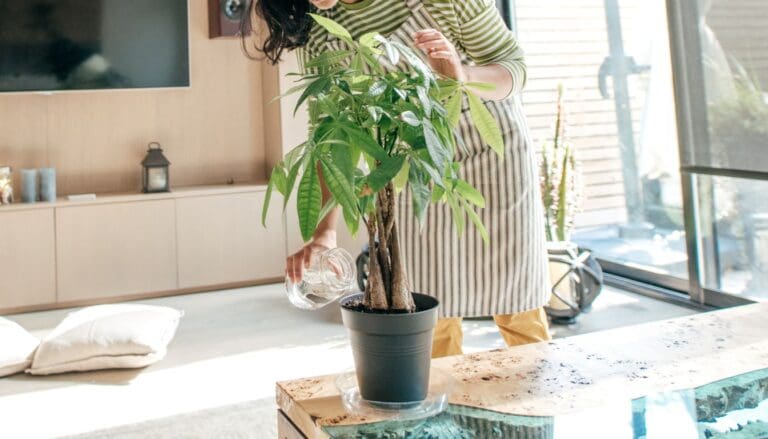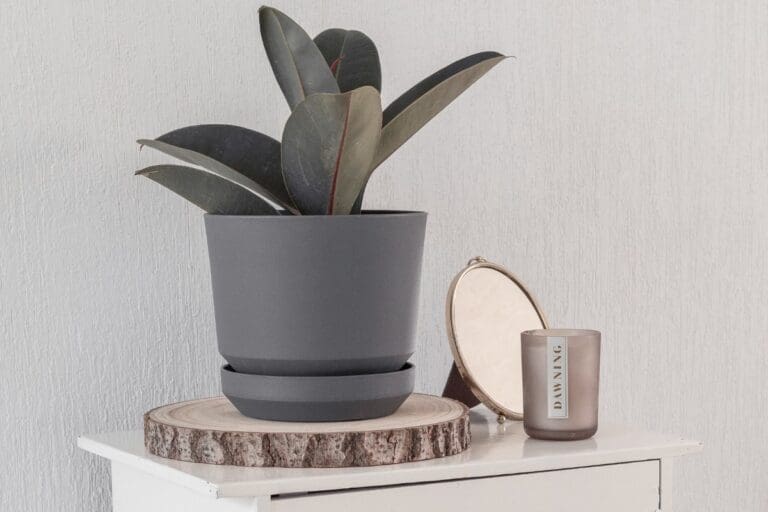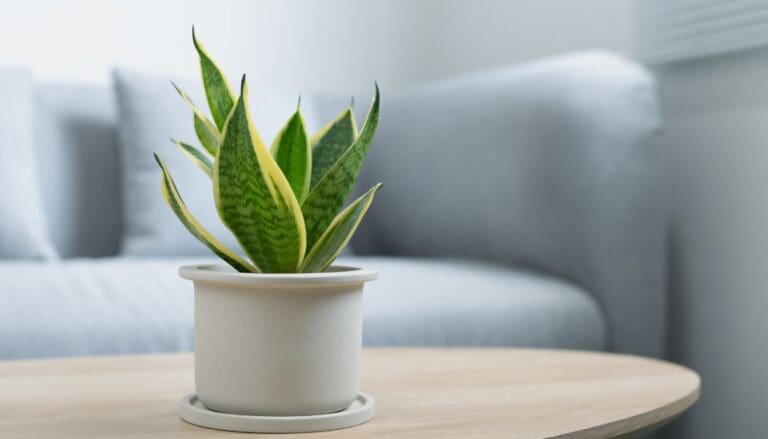Can Crotons Survive Winter? (Common Problems+Care Guide)
Crotons are popular houseplants that have colorful and attractive foliage. Since these plants come from tropical regions, warm conditions are ideal. If you are wondering whether a croton plant can survive winter, you have landed on the right page.
Crotons will survive winter if you protect them from freezing temperatures below 40°F. If your region experiences heavy snowfall or temperature below the freezing point, then you might have to bring your crotons indoors. It would be best to protect your crotons from cold northern winds as well.
In this article, I will convey my knowledge of caring for croton plants during winter. If that is what you are looking for, keep reading.

Please note: Simplify Plants is reader-supported. Some links in the post are affiliate links and I get a commission from purchases made through links in the post.
How do you keep Crotons alive in the winter?
Crotons are tropical plants, and like most tropical plants, Crotons don’t prefer low temperatures.
In winter, the temperatures may go much lower than the preference of crotons, and that is when it will need your support.
If you want to keep your Crotons alive and happy during winter, you must follow the correct care routine appropriate for the season.
But now that you are here read the following points to understand the requirements and actions you should take for your Croton during winter.
Croton plant winter care
Croton will thrive in winter if you give it some attention and a little extra care.
1. Provide sufficient sunlight to your Croton

Crotons love sunlight. While some varieties enjoy full sun, some prefer bright indirect light.
But one thing to remember here is that Crotons are not low-light plants.
This can become a problem during winter as the intensity and duration of sunlight reduces during winter.
To deal with this, you need to place your croton in a spot that receives ample sunlight.
Place the croton near a south-facing window to give it the highest sunlight exposure.
Ensure to clean the windows so that the plant gets as much sunlight as possible.
When the temperatures remain low, don’t keep the croton too close to the window, resulting in a cold shock.
You can take it outside for a few hours when the temperatures are not too low.
But if you think your croton is not getting enough sunlight, use artificial lights.
Many artificial lights in the market are designed to provide appropriate light and warmth to the plants.
Get one for your croton or other houseplants and use it during the winter, especially if your house doesn’t receive enough natural light.
Also, rotate the plant to give it light on all sides. Otherwise, the plant will grow unevenly.
Keep the leaves clean to help them absorb more light.
Also read: What Kind Of Light Does A Croton Need? (Croton Light Requirements )
2. Water the croton wisely during winter.
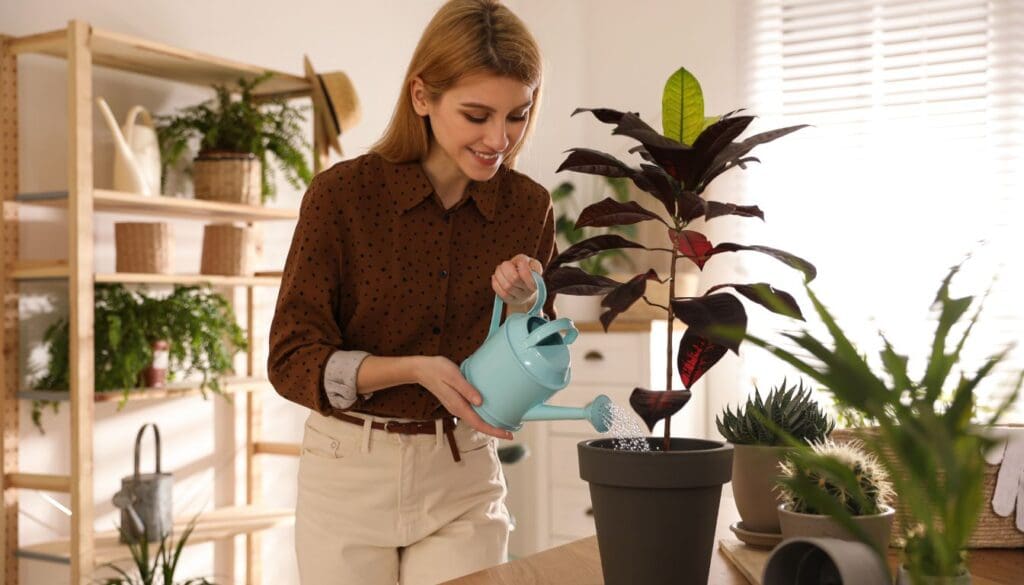
If your croton has been thriving in the summer and spring seasons, you must have gained an idea of the plant’s water requirement.
However, that will not work in winter.
Along with all the changes in the weather conditions, the water requirement of the croton also changes.
The best thing is to always check the soil before watering the croton.
You must water the croton only when the topsoil feels dry.
Don’t worry if you are unsure of this. A moisture meter can tell you if you need to water the plant or not.
If you don’t have a moisture meter, insert your finger into the soil or lift the pot to understand if your croton requires water.
In general, the water requirement of the croton will reduce during winter.
It will likely need half of its usual water intake during the spring and summer.
But every plant has different needs, so checking the soil’s moisture before watering is the best way to go about it.
You must not skip the watering as crotons prefer moist soil.
Also read: How Often To Water Croton Plant? (Watering Schedule+Watering Problems)
3. Fertilize your croton less in winter.

Most houseplants don’t require any fertilizer in winter, but it is a little different with croton.
Crotons don’t go into dormancy in winter. They rest but don’t go completely dormant.
Therefore, you must not stop fertilizing altogether.
Instead, use a diluted liquid fertilizer to feed the plant. Fertilizing once a month will be sufficient.
If you repotted your croton right before winter, you wouldn’t need to fertilize it as it will already get the required nutrients from the soil.
But never overfeed the croton as it can bring many problems that can be difficult to deal with.
Also read: What Fertilizer Is Good For Croton? (Best Fertilizer For Croton Plant)
4. Take care of the humidity.

Humidity is vital for tropical plants.
Since they come from warm and humid regions, they will not react well to places with low humidity.
You might achieve the required humidity during the spring and summer months, but providing sufficient humidity can become an issue during winter.
In winter, the humidity levels drop drastically in many regions.
If you live in such a region, the croton might get stressed without enough humidity.
But there are various ways to increase the humidity levels around the plant.
You can:
- Get a humidifier.
- Group the croton with other moisture-loving plants.
- Prepare a pebble tray and place the croton on it.
- Keep the croton near an aquarium if you have one.
- Relocate the plant to a more humid spot such as a bathroom or kitchen.
Also read: Do Crotons Need Misting? (+Maintaining Ideal Temperature)
5. Keep the croton warm during winter.

The ideal temperature range for croton is 65-80°F, but that’s not what they get in winter.
The temperature can go low in winters, along with frost and cold drafts.
You must not expose your croton to such adverse conditions and try to keep it warm.
Here are some tips to keep the croton warm during winter.
- Bring the croton inside if it is outside.
- Keep the croton away from chilly windows.
- Put a shade between the window and the croton.
- Place the croton in a warm room.
- But don’t keep it too close to any heating sources.
6. Avoid temperature fluctuations.
During winter, the indoor and outdoor temperatures vary a lot.
If you don’t keep your croton at the right spot, it can experience stress due to temperature fluctuations.
First, avoid windows and doors that are opened and closed frequently.
These spots can stress out the plant with temperature fluctuations.
Therefore, don’t keep the croton near such locations.
You might use heaters to keep the indoors warm in winter, but you must never keep the croton too near them.
Also read: What Temperature Can Croton Tolerate? (+Ideal Temperature Range)
Do Crotons come back after winter?

Crotons might experience some stress during winter if exposed to unfavorable conditions, but they will not die.
If you can identify the cause of its stress and address the issue by taking the appropriate action, you can bring the croton back to health.
Croton winter problems
Some common problems that the croton might face in winter are:
Spider mites infestation
During winter, the air goes dry, and the temperatures fall below normal.
Such conditions are ideal for spider mite infestation.
If your croton doesn’t get enough humidity or water, it might get attacked by pesky spider mites.
Spider mites resemble spiders but are tiny and remain on the undersides of leaves.
These pests suck the sap of the croton, making the plant weak and vulnerable.
Getting rid of these pests is urgent as they can kill your croton if you leave them on the plant.
- Give the croton a strong shower to remove the spider mites.
- You can spray the plant with a neem oil solution to remove the spider mites.
- Take a cotton ball, dip it in rubbing alcohol and apply it to the affected parts.
- If nothing works, use a pesticide.
- Don’t keep your croton dry, as that will again attract spider mites.
Also read: How Do I Get Rid Of Bugs In My Croton Plant? (Common Bugs+Fix)
Falling leaves
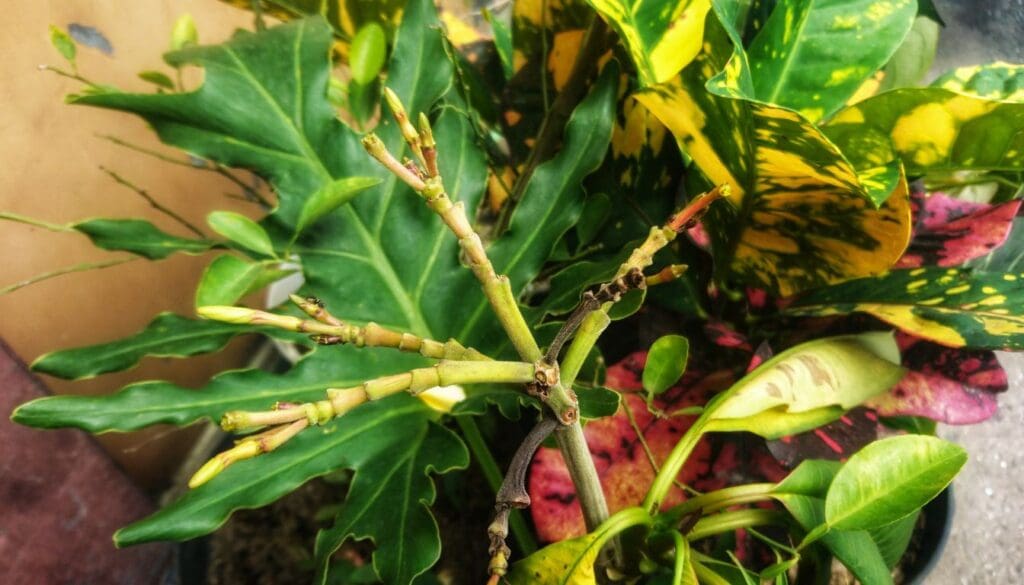
The plants might get stressed during winter due to low light, temperatures, and humidity.
Due to the stress, you might notice leaves falling off your croton.
Don’t get too worried, as you can fix this by ensuring that you provide the ideal conditions to your croton, as I already mentioned previously.
Root rot
Many plant owners don’t understand the change of requirements of their plants in winter and end up making mistakes, one of which is overwatering.
Overwatering your croton can lead to root rot, where the roots get severely damaged and rot.
Root rot is dangerous and must be avoided at all costs. So it would be better if you could prevent it in the first place.
Don’t water without checking the soil and water only if the top layers of the soil feel dry.
Also read: What Kind Of Pot For Croton? (Pot Size, Material & More)
Leggy growth
Winter conditions can make your croton leggy.
Don’t shy away from pruning the plant if your croton looks uneven and leggy.
You can also pinch young leaves to promote more foliage growth.
Also read: Why Is My Croton Leggy? (Possible Causes+How To Fix)
Final words

To sum it up, crotons will survive winter with the correct care routine and some attention. Even if some problem occurs, you can fix it by identifying the cause and addressing the issue.
Keep a check on the temperature, provide more humidity, reduce the watering and fertilize the croton less during winter. Too much dryness can invite issues like pest infestation and falling leaves, whereas watering more than your croton needs can cause root rot.
Altering the care routine of your plant to match the season is the right way of helping your croton survive the winter.
Reference: Sciencedirect, Wikipedia, Wikipedia, Britannica, CABI, Academia, University of South Florida, The University of Georgia.
Recommended Garden Supplies
| Product Image | Our Recommended Gardening Supplies | Check Offers! |
|---|---|---|
Top Top
Top
Top
Top
Top
Top
Top
Top | rePotme Houseplant and Tropical Classic Potting Soil Mix | Check Offer On Amazon |
 Top
Top
Top
Top
Top
Top
Top
Top | Espoma Organic Indoor Plant Food | Check Offer On Amazon |
 Top
Top
Top
Top
Top
Top
Top
Top | GooingTop LED Grow Light 6000K Full Spectrum Clip Plant Growing Lamp | Check Offer On Amazon |
 Top
Top
Top
Top
Top
Top
Top
Top | Soil Moisture Meter | Check Offer On Amazon |
 Top
Top
Top
Top
Top
Top
Top
Top | Govee Hygrometer Thermometer, Bluetooth Enabled! | Check Offer On Amazon |
 Top
Top | LEVOIT Humidifiers for Large Room(Best For Plants) | Check Offer On Amazon |
 Top
Top
Top
Top
Top
Top
Top
Top | Upgraded DIY Automatic Drip Irrigation Kit, 15 Potted Houseplants Support | Check Offer On Amazon |
 Top
Top
Top
Top
Top
Top
Top
Top | Stainless Steel Heavy Duty Gardening Tool Set | Check Offer On Amazon |
 Top
Top
Top
Top
Top
Top
Top
Top | Bonide Insecticidal Soap | Check Offer On Amazon |
 Top
Top
Top
Top
Top
Top
Top
Top | Bonide 32 oz Spray Neem Oil for Organic Gardening | Check Offer On Amazon |
 Top
Top
Top
Top
Top
Top
Top
Top | Garden Safe Fungicide | Check Offer On Amazon |

